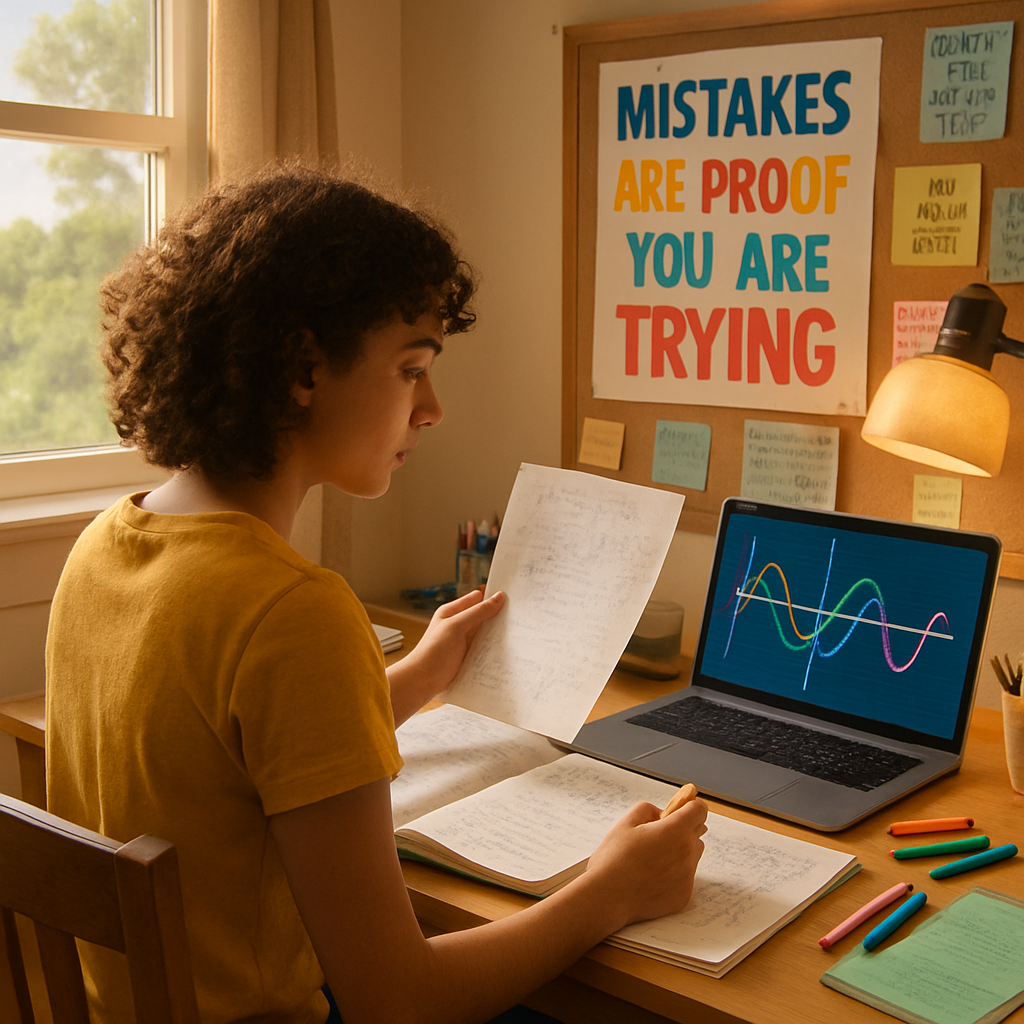
1. Rethink How You See Math
What to do:
- Embrace mistakes. Instead of panicking over wrong answers, ask yourself, “What did this teach me?” Every mistake shows you the next step in your learning.
- Value effort, not speed. The fastest student isn’t always the one who understands best. Taking time to break things down means you’ll actually remember it.
- Use the word “yet.” Saying “I can’t do logarithms yet” shifts the focus from being stuck to making progress.
2. Fix the Foundations First
Examples of how gaps show up:
- If fractions and integers are confusing, algebra feels impossible.
- Without solid ratios, geometry problems won’t make sense.
- Trigonometry and calculus require strong algebra skills.
- Review old skills. Spend 10 minutes a day reviewing earlier topics. Sometimes, reviewing topics like fractions or percentages clears up today’s confusion.
- Ask your teacher. Many schools use benchmark tests to identify areas where students need additional practice. Don’t be afraid to ask your teacher to see your test scores to find out the areas you struggle with most.
- Use adaptive tools. Platforms like StarSpark.AI track your skill level as you work with an AI-powered teacher, identify the areas where you’re stuck, and give you personalized practice and clear instruction to strengthen those gaps until they stick.
3. Practice Smarter, Not Just Longer
- Space it out. Instead of cramming before a test, study in short daily sessions. Research shows spaced practice helps your brain move information into long-term memory.
- Mix it up. Don’t just drill 20 of the same type of problem. Mix different topics so you get used to recognizing what kind of problem it is and which strategy to use.
- Redo mistakes. Keep a “mistake log” where you write down problems you got wrong and solve them again until they make sense. This is where real learning happens.
- Use time pressure. Occasionally, do problems under a timer. This helps you build confidence for real test conditions.
- Use smarter tools. StarSpark.AI makes practice faster and more efficient by figuring out exactly where you’re struggling. Instead of guessing what to review, it targets the skills you need most, gives you personalized practice, and explains concepts step by step so you don’t waste time on what you already know.
4. Make Math Visual
How to make math visual:
- Draw it out. For geometry, sketch the problem. Label every side, angle, and relationship. Visualizing triangles or circles often makes a complicated word problem much simpler.
- Graph functions. Use graph paper or digital tools like Desmos. Seeing how the line shifts when you change the slope or y-intercept is much clearer than memorizing “y = mx + b.”
- Color-code your steps. Use highlighters or different pen colors when solving multi-step equations. Your brain organizes information better when you separate the pieces visually.
- Use models and objects. For example, use blocks to represent algebraic expressions, or pie charts to represent fractions. Physically “seeing” a problem builds intuition.
How to make math real:
- Shopping discounts. If a hoodie is 30% off, calculate the final price before you get to the register. That’s percentages in action.
- Sports stats. Basketball shooting percentages, baseball batting averages, or fantasy football odds all rely on probability and data analysis.
- Cooking and baking. Doubling or halving a recipe is an instant lesson in ratios and fractions.
- Daily routines. Calculate the time it takes to walk to school at different speeds, or estimate the probability of being late if you hit two red lights.
- Graphs and diagrams to show what’s happening step by step.
- Visual breakdowns of abstract ideas like trig ratios, quadratic functions, or probability.
- Interactive practice with multimodal features to draw, type, speak, or upload a problem.
5. Use a Variety of Resources
Build your math toolkit:
- Class resources. Your teacher’s notes and practice sheets are your first stop. They align directly with your curriculum and will be closest to what shows up on tests.
- Online explanations. Websites like Khan Academy and YouTube tutorials offer clear, step-by-step breakdowns of the same concepts in different styles. Hearing it explained another way can be the key to making it stick.
- Interactive tools. Platforms like Desmos let you play with functions, graphs, and equations so you can see how changing one part affects the whole. This is especially helpful for visual learners.
- Study groups. Explaining a problem to a friend forces you to think differently. Teaching others is one of the fastest ways to strengthen your own understanding.
- Adaptive support. Tools like StarSpark can act as your on-demand teacher. Instead of replacing your other resources, it pulls them together by giving you real-time, step-by-step explanations and personalized practice based on what you’re working on in the classroom right now, with 100% accuracy.
6. Prepare with Purpose for Big Tests
- Start at least 2–3 months ahead, not the week before.
- Use official practice exams from the College Board or ACT. They’re the closest to the real thing.
- Focus on the topics that appear most often. For SAT, that’s algebra, problem solving, and data analysis. For AP Calculus, focus on derivatives and integrals.
- Always review your mistakes in detail. Don’t just mark them wrong—figure out why they were wrong.
- Use StarSpark. Get custom, targeted practice or build your own practice sets around the areas you struggle with most. If you get stuck, the AI-powered teacher breaks it down step by step so you can actually understand the process, not just the answer. For extra support, the Teach Me feature gives you quick mini-lessons to review older skills or learn new ones—perfect for filling gaps before moving on.
7. Build Confidence Through Small Wins
How to build math confidence:
- Set mini-goals. Instead of trying to master an entire chapter at once, focus on something you can accomplish today, like “solve five equations without help” or “review ratios for 15 minutes.”
- Track your growth. Keep a simple journal or use an app to record quiz scores, homework progress, or even the number of problems you solved correctly. Watching the numbers go up over time is motivating proof that you’re improving.
- Celebrate effort. Success isn’t only about getting the right answer. Finishing a tough assignment, reworking a problem you missed, or staying calm during practice are all real wins worth celebrating.
- Use reflection. After a study session, write down one thing that felt easier than last time. This helps you notice progress you might otherwise overlook.
8. Ask for Help Early
- Teachers during office hours or after class.
- Friends or classmates who explain it differently.
- Online tutorials and forums.
- StarSpark, which is like having a teacher in your pocket—ready to explain problems at any time, without judgment.
Why Students Choose StarSpark
- Grade-level alignment. Every explanation and practice set is built around K–12 and AP-level state standards, so you’re practicing exactly what’s expected in class and on exams.
- Step-by-step teaching. Stuck on a problem? StarSpark doesn’t just give you the answer. It breaks the problem down into clear, logical steps, teaching you how to solve it on your own.
- Teach Me mini-lessons. When you need more background, StarSpark offers short refreshers that review earlier concepts or introduce new ones, filling in the “why” behind the math.
- Tailored to your learning style. Whether you prefer typing, drawing, speaking, or uploading your work, StarSpark adapts to you with multimodal features that respond to the way you learn best.
- Targeted practice. Instead of wasting time guessing what to study, StarSpark generates custom problem sets to strengthen the exact areas where you’re struggling.
- Visual explanations. With automatically generated graphs, diagrams, and illustrations, StarSpark makes abstract concepts like quadratics or trigonometric functions concrete and easier to understand.
- Built for math, with 100% accuracy. Unlike generic AI tools, StarSpark was built from the ground up for math. You can trust the answers and explanations to be correct every time.
- Confidence building. Progress tracking and small wins help you see how far you’ve come—turning frustration into motivation.
Final Thoughts
Getting better at math in high school isn’t about being naturally gifted—it’s about finding the right strategies, putting in consistent effort, and using the tools available to you.
FAQs
How can I get better at math in high school?
Focus on the basics first, then practice consistently in short daily sessions. Mix different types of problems, review mistakes, and use visual tools. Targeted practice from platforms like StarSpark helps you study smarter, not just longer.
What is a growth mindset in math?
A growth mindset means believing that your math skills can improve with effort and persistence. Students with a growth mindset embrace mistakes, see challenges as opportunities, and stick with tough problems longer—leading to better results.
How does StarSpark help with math homework?
StarSpark checks your answers, explains problems step by step, and gives you practice that adapts to your skill level. Instead of just giving answers, it helps you actually learn the process.
Is StarSpark aligned to my grade level and state standards?
Yes. StarSpark is built specifically for K–12 and AP math with state-standard alignment, so what you practice matches what you see in class and on tests.
What makes StarSpark different from generic homework apps?
StarSpark is designed for learning, not shortcuts. It explains step by step, creates visuals like graphs and diagrams, and offers “Teach Me” mini-lessons to review older concepts or learn new ones.
Does StarSpark support different learning styles?
Yes. With multimodal features, you can type, draw, speak, or upload problems. StarSpark responds in the way that works best for you—whether that’s text, visuals, or voice.
Can StarSpark create targeted practice for my weak areas?
Yes. StarSpark identifies your struggles and creates custom practice sets so your study time is focused, faster, and more effective.
Is StarSpark accurate?
Absolutely. StarSpark was built specifically for math, with 100% accurate explanations and solutions you can trust.
Will StarSpark help with SAT, ACT, or AP math?
Yes. StarSpark covers high school and AP topics and can target the skills most often tested on standardized exams, helping you prepare under real test conditions.
How long until I see improvement in math?
Most students notice progress in a few weeks if they practice 15–30 minutes a day, review their mistakes, and focus on their weak areas.
Can StarSpark replace a tutor?
For many students, yes. StarSpark acts like a personal teacher that’s available anytime, offering explanations, lessons, and targeted practice at a fraction of the cost.




